Legacy
Pankow Legacy
Charles Pankow (1923-2004) graduated from Purdue University with a Bachelor of Science in Civil Engineering in 1947, and 36 years later he was honored by Purdue with an Honorary Doctorate in Engineering. His college education was interrupted by military service during WWII. As a U.S. Navy ensign, he was stationed in Japan until 1946.
After 15 years in the design and build industry, "Charlie," as he was known to his family, friends and colleagues, formed his own construction company in 1963. For more than 40 years, he was a pioneer in concrete-forming technology and a champion of the design-build method for faster and more efficient construction of buildings (Pankow Builders once completed a 40-story condominium in seven months).
During his distinguished career, Charlie invented processes for manufacturing hollow concrete piles using a slip-form technique and slip-forming vertical air conditioning ducts; he created innovative systems for increasing project automation, including total onsite precasting of structural and architectural elements; and he is perhaps best-known for his leadership in the development of moment-frame technology that has advanced the science of earthquake resistant construction.
Charlie was a leading member of more than a dozen national associations and academies, including the American Concrete Institute (ACI), American Arbitration Association, Structural Engineers Association of Southern California, and American Society of Civil Engineers (ASCE), among others. In 1980 Charlie served as president of the American Concrete Institute (whose Southern California Chapter he had helped form in 1957-the first local ACI chapter in the U.S.). He was elected into the National Academy of Engineering in 1997. He was a noted speaker at numerous state and national conventions, and he authored several chapters in the Concrete Construction Handbook by Joseph Waddell.
Charlie was especially honored in 1999 to be recognized by Engineering News-Record as one of the Top Six World Builders during ENR's 125-year history. His career was also replete with other awards and peer recognition for his many contributions, such as Design-Build Institute of America's Brunelleschi Medal for Lifetime Achievement in 2003; ASCE's 2002 OPAL Award for Outstanding Lifetime Achievement in Construction; Purdue University's Distinguished Alumnus Award; ACI's Henry C. Turner Medal Award in 1990; Los Angeles Area Chamber of Commerce Industry Achievement Award in 1993; and many others.
Charlie was well known as a connoisseur of the arts, having established a considerable collection of ancient Egyptian, Chinese and Russian artifacts. He amassed one of the largest private collections of Russian and Greek icons in the United States. Charlie also contributed generously to numerous educational institutions and charitable organizations over the years, most notably Purdue University.
A Better Way to Build:
A History of the Pankow Companies
The Charles Pankow Oral History Project
at Purdue University
The ASCE Charles Pankow Award for Innovation recognizes the contributions of organizations working collaboratively to advance the design and construction industry by introducing innovation into practice.
View the list of recipients of this coveted award.


